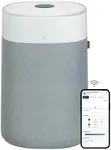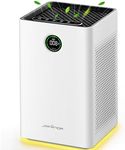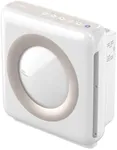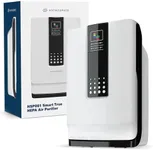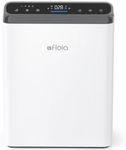Buying Guide for the Best Air Purifiers For Allergies
Choosing the right air purifier for allergies can make a big difference in your comfort and health at home. The main goal is to find a device that effectively removes allergens like dust, pollen, pet dander, and mold spores from the air. To do this, you’ll want to pay attention to a few key features that determine how well the purifier works, how easy it is to use, and how suitable it is for your living space. Understanding these features will help you match the purifier to your specific needs, whether you have mild seasonal allergies or more severe sensitivities.Filter TypeThe filter type is crucial because it determines what kinds of particles the air purifier can capture. The most common and effective filter for allergies is the HEPA filter, which can trap very small particles like pollen, dust mites, and pet dander. Some purifiers also include activated carbon filters, which help with odors and some gases. When looking at filter types, focus on true HEPA filters for allergies, as these are tested to capture at least 99.97% of particles as small as 0.3 microns. If you have chemical sensitivities or want to reduce odors, consider a model with an additional carbon filter. Your choice should depend on whether your main concern is particles, odors, or both.
Room Coverage (CADR and Square Footage)Room coverage tells you how large of a space the air purifier can effectively clean. This is often measured in square footage or by the Clean Air Delivery Rate (CADR), which indicates how quickly the purifier can remove particles from the air. Higher CADR numbers and larger square footage ratings mean the purifier can handle bigger rooms. To pick the right one, measure the size of the room where you’ll use the purifier and choose a model rated for at least that size. If you have open floor plans or want to use the purifier in multiple rooms, consider a higher coverage rating.
Noise LevelNoise level is important, especially if you plan to use the air purifier in a bedroom or living area. Noise is usually measured in decibels (dB), with lower numbers being quieter. Some purifiers have multiple speed settings, so they can run quietly at night and more powerfully during the day. If you’re sensitive to noise or want to use the purifier while sleeping, look for models with a low noise rating or a dedicated sleep mode. Think about where you’ll place the purifier and how much background noise you’re comfortable with.
Filter Replacement and MaintenanceFilter replacement and maintenance affect how easy and affordable it is to keep your air purifier working well. HEPA and carbon filters need to be replaced regularly, usually every 6 to 12 months, depending on usage and air quality. Some purifiers have filter change indicators to remind you when it’s time. When choosing a purifier, check how often the filters need changing and how easy it is to access and replace them. If you prefer low-maintenance options, look for models with longer-lasting filters or easy-access designs.
Additional FeaturesAdditional features can make using your air purifier more convenient or effective. These might include air quality sensors, automatic mode, timers, remote controls, or smart connectivity. Air quality sensors can adjust the purifier’s speed based on the amount of pollution detected, which is helpful for allergy sufferers. Timers and remote controls add convenience, while smart features let you control the purifier from your phone. Consider which features would make your daily use easier or more comfortable, based on your lifestyle and preferences.





